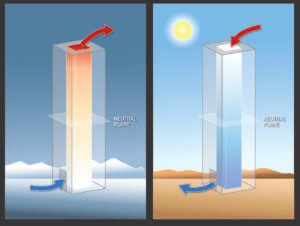News
Get to know a flow feature: The stack effect
 The stack effect is simultaneously one of the most useful and most problematic flow features in building design. Use it to your advantage, and the stack effect can enhance ventilation, improve exhaust dispersion, and make tall buildings more pleasant places to live and work. Ignore it, and you could end up with unusable doors, high heating and cooling costs, and disgruntled occupants.
The stack effect is simultaneously one of the most useful and most problematic flow features in building design. Use it to your advantage, and the stack effect can enhance ventilation, improve exhaust dispersion, and make tall buildings more pleasant places to live and work. Ignore it, and you could end up with unusable doors, high heating and cooling costs, and disgruntled occupants.
The stack effect is the tendency for air to move vertically through buildings and stacks (chimneys) because of buoyancy. Buoyancy, in turn, is the physical mechanism by which warm air rises above cooler air. It’s all about relative density, the same reason that oil floats on water.
In tall buildings, warm air rises from bottom to top, creating an upward draft. Air at ground level enters the building through whatever openings are available to it (windows, doors, breaches in cladding) in order to replace the rising air that exits the building through similar openings at the top. Elevator shaft, stairwells, utility conduits, and other unpartitioned spaces are particularly vulnerable to stack effects.
Failing to plan for the stack effect can cause some real problems. For example,
- The taller the building, the greater the pressure difference between air at upper floors and at the ground floor. This pressure difference induces high wind speeds at the base, making it difficult to open and close conventional hinged doors. In fact, the stack effect is a key reason for the use of the revolving door in tall buildings.
- The large, open nature of atria makes them particularly vulnerable to smoke in the event of an atrium fire. A fire at ground level creates a rising plume of smoke and hot air, which accumulates at the ceiling. As the smoke accumulates, it makes egress more and more difficult for the building’s occupants, and the longer the fire burns, the lower the smoke reaches.
- When occupants enter a building’s ground floor in cold weather, occupants near entryways may become cold, prompting them to turn up the thermostat. However, this warm air adds to warm air already flowing up through the building, causing upper floor occupants to turn down their thermostats, or even open windows. This induces a sort of positive feedback loop that only serves to increase ventilation rates and degrade the comfort of all involved.
But the stack effect can also be used to one’s advantage. Designers of natural ventilation schemes, for instance, relying upon buoyancy-induced airflow to move air through a building’s envelope and flush out pollutants and heat. Some heating, ventilation, and air conditioning (HVAC) systems also exploit the stack effect to improve exhaust rates. And the very same rising hot air plume that causes smoke accumulation in an atrium fire can actually be used to enhance smoke exhaust when the stack effect is considered as part of the solution.
It’s important to know that wind pressures can quickly overcome stack effect where there are openings in the building envelope. In other words, it’s not enough to understand stack effect if you do not consider the wind’s effects on the building. Consult a qualified wind engineer (preferably one of ours!) to ensure your project effectively accounts for wind and stack effects.
At CPP, our technical experts tackle indoor and outdoor air flow challenges every day. If you are designing a new building or retrofitting an existing one, we can help your project succeed. With a sophisticated understanding of issues involving moving air and the expertise to solve them, we’ll help you ensure that your building is safe, comfortable, and efficient.
